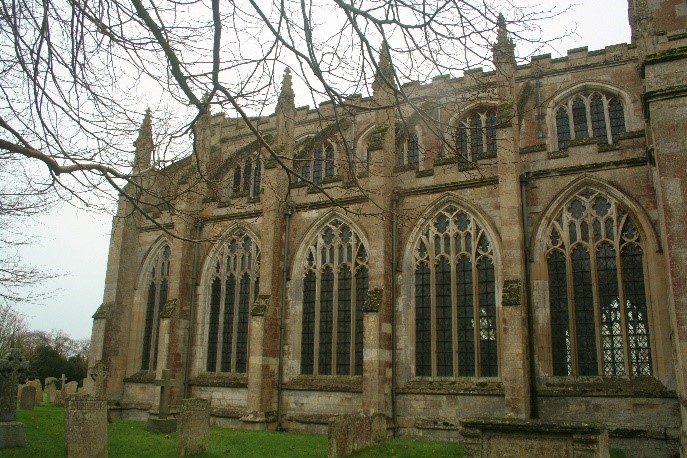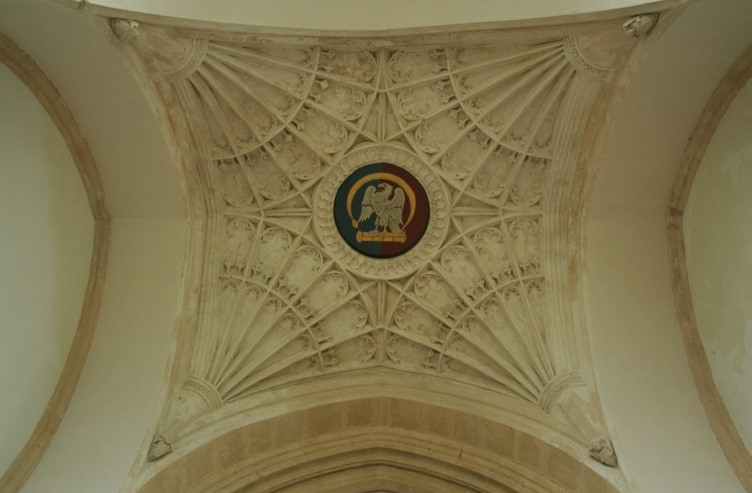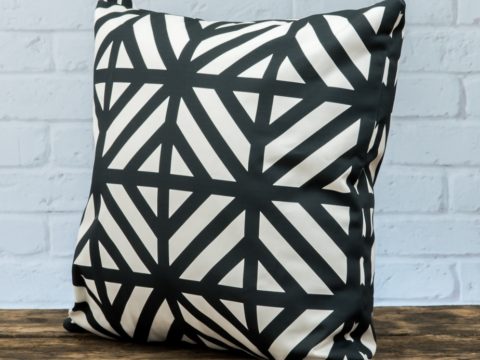Fotheringhay Castle & Church
Chapter 3 : The Church
The Church, dedicated to St Mary and All Saints, is situated in the middle of the village. There is a square tower at the west end, and the overall effect is of a rather truncated building – originally, beyond the current east wall, were further buildings. These buildings were for the College, founded (or perhaps refounded) by Edmund of Langley. The College consisted of one master and 12 chaplains, and was dedicated to the Annunciation of Our Lady and St Edward the Confessor. Initially, it seems the College was to be attached to the Castle chapel, but it is not clear whether that ever happened. (A College was not an educational establishment, but a group of priests, dedicated to a particular purpose).

In 1411, Edward, 2 nd Duke of York, transferred the College to the parish church. The final complement of inmates was a Precentor, 11 chaplains, eight clerks and 13 choristers all supervised by a Master. In addition Duke Edmund built almshouses for ten of ‘ Christ’s poor’. The objectives of the College were to pray for the souls of Edmund and Isabella of Castile, Edwards parents, Henry V, Richard II, and all the faithfully departed. A new choir was built, where, after Agincourt, his bones were to be interred. Work had not been completed by his death, and it was not until 1434 that the work was completed by Richard, 3 rd Duke of York who employed William Horwood as his master-mason. It is probable the works were completed by 1441.
In 1461, Richard’s son became Edward IV, following the Yorkist victory at Towton. In 1476, he arranged for his father and brother to be exhumed and their bodies brought to Fotheringhay where an impressive ceremony was held to reinter them in their family Church. The ceremony was described by Thomas Whiting, Chester Herald (modern spelling – thanks to Fotheringhay Church).
‘On 24 July, the bodies were exhumed, that of the Duke garbed in ermine-furred mantle and Cap of Maintenance, covered with cloth of gold lay in state on a hearse blazing with candles, guarded by an angel of silver, bearing a crown of gold as a reminder that by right, the Duke had been King. On the journey, Richard, Duke of Gloucester, with other Lords and officers at arms, all dressed in mourning, following the funeral chariot, drawn by six horses, with trappings of black, charged with the arms of France and England and preceded by a knight bearing the banner of the ducal arms. Each night they rested – Doncaster, Blyth, Tuxford-le-Clay, Newark, Grantham, Stamford - and finally Fotheringhay church was reached on 29th July where members of the College and other ecclesiastics, went forth to meet the cortege. At the entrance to the churchyard, King Edward IV waited, together with the Duke of Clarence, the Marquess of Dorset, Earl Rivers, Lord Hastings and other noblemen. Upon the arrival, the King made obeisance to the body right humbly and put his hand on the body and kissed it, crying all the time. The procession moved into the church where two hearses were waiting, one in the choir for the body of the Duke and the other in the Lady Chapel for that of the Earl and after the King had retired to his closet, the princes and officers of arms had stationed themselves around the hearse, masses were sung, and the King's Chamberlain offered him seven pieces of cloth of gold which were laid in a cross on the body. The next day three masses were sung, the Bishop of Lincoln preached a very noble sermon and offerings were made by the Duke of Gloucester and the other Lords. There were presented the Duke of York's coat of arms, his shield, his sword, his helmet and his courser on which rode Lord Ferrers in full armour, holding in his hand an axe reversed. When the funeral was over, the people were admitted into the church and it is said that before the coffins were placed in the vault which had been built under the chancel, 5000 people came to receive the alms, while four times that number partook of the dinner, served partly in the castle and partly in the King's tents and pavilions. There they partook of so many good things that the bills for it amounted to more than £300 – more than cost of the church built only 30 years before.’
Lady Margaret Beaufort, wife of Lord Stanley, was in the retinue of Queen Elizabeth Woodville for the occasion.
The College was dissolved, probably in 1548 (records are inconsistent and some sources state 1538) and the lands were granted to John Dudley, Duke of Northumberland. On his execution for treason in 1553, his lands would have reverted to the Crown. The College buildings were sold in 1558 to James Cruys. In 1572, a Commission set up to enquire into the state of the buildings, decided that they should be demolished. It is alleged that Queen Elizabeth, visiting in 1573, saw the tombs of her ancestors in the ruins of the College and commanded that they be brought into the church. Whether or not it was on her orders, memorials to Duke Richard and Duchess Cicely were built by Sir Edmund Brudenell of Deene and may still be seen at the east end, either side of the altar.

The Church is built in the perpendicular style of the mid-15th century which gives an enormous amount of light. Internally it is very plain, other than the small area of fan vaulted ceiling, constructed in 1529 which now sports the Falcon and Fetterlock badge of York. There is only one stained-glass window and that is modern, showing the badges of the house of York, and the families into which they married.






